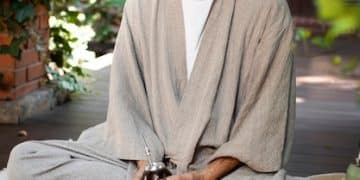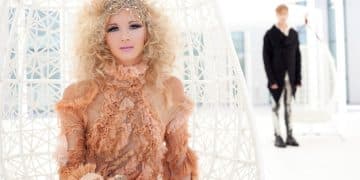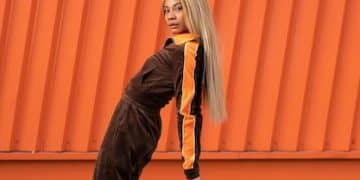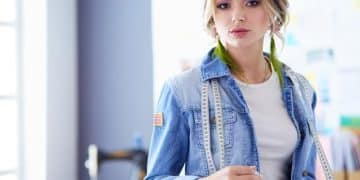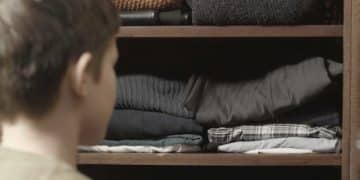$10 Transformation: Upcycling a Thrift Store Dress for the Runway
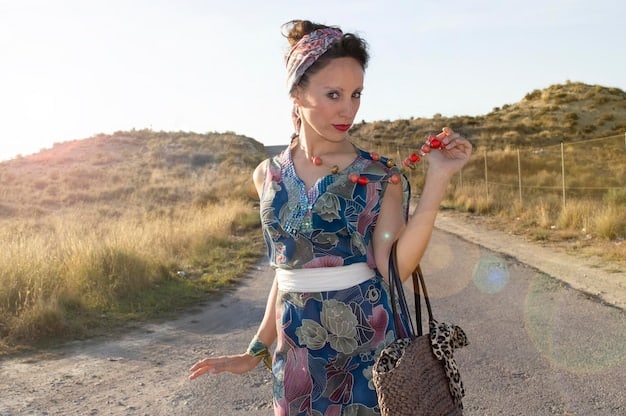
Turning a $10 thrift store find into a runway-worthy outfit is possible through upcycling, demonstrating that creativity and resourcefulness can result in high-fashion transformations, challenging the perception of budget fashion.
Can you turn a $10 thrift store dress into a show-stopping runway look? The upcycling challenge: transforming a $10 thrift store dress into a runway-ready outfit might sound impossible, but with creativity and a few clever techniques, you can create a stunning and unique piece that defies expectations.
The Allure of the Upcycling Challenge
Upcycling has become increasingly popular, driven by both environmental awareness and the desire for unique fashion pieces. Taking on an upcycling challenge pushes your creative boundaries and provides a sustainable alternative to fast fashion.
Transforming a simple, inexpensive garment into something extraordinary is not only satisfying but also a statement about conscious consumption. Let’s explore why this trend is catching on and how you can participate.
Why Choose the Upcycling Route?
Upcycling offers several compelling benefits. It reduces waste, encourages creativity, and allows you to create one-of-a-kind pieces. Here’s a deeper look:
- Environmental Impact: By repurposing existing materials, you reduce the demand for new resources and minimize textile waste, which is a significant environmental problem.
- Unique Style: Upcycled clothing is inherently unique. You won’t find the same design anywhere else, allowing you to express your individuality.
- Cost-Effective: Transforming a $10 dress is far more budget-friendly than buying a new designer piece, making high fashion accessible without breaking the bank.
Embracing upcycling means participating in a movement that values creativity, sustainability, and personal expression. You not only get a fashionable new outfit but also contribute to a more responsible fashion industry.
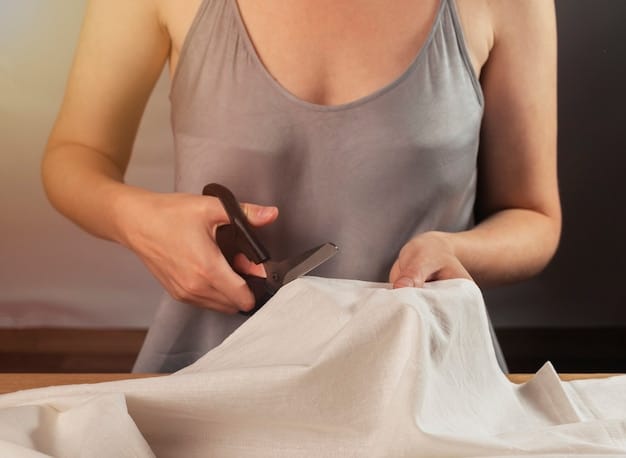
Finding the Perfect Thrift Store Dress
The first step in an upcycling challenge is finding the right thrift store dress. Look for pieces that have potential in terms of fabric quality, interesting patterns, or unique structural elements. Don’t worry too much about the initial appearance; focus on the possibilities it holds.
Consider the dress as a blank canvas, ready to be transformed into something new and exciting. Here’s how to approach your thrift store shopping:
What to Look For
When scouting for a dress to upcycle, consider these factors:
- Fabric Quality: Choose durable fabrics that can withstand alterations. Natural fibers like cotton, linen, and silk are excellent choices.
- Pattern and Color: Select dresses with interesting patterns or colors that align with your vision. Bold prints or unique textures can add character to your upcycled creation.
- Size and Shape: Bigger is better. An oversized dress provides more fabric to work with, allowing for greater flexibility in design.
Remember, the goal is to find a dress with good bones—something that can be reimagined and reshaped to fit your style and vision. Don’t be afraid to think outside the box and see the potential in seemingly ordinary items.
Design Inspiration: Runway Trends to Incorporate
To elevate your upcycled dress to runway status, draw inspiration from current fashion trends. Research recent runway shows and identify elements that you can incorporate into your design. Asymmetrical cuts, bold embellishments, and unexpected textures are all great options.
Incorporating these trends can transform your thrift store find into a high-fashion statement. Here’s how to find and apply runway inspiration:
Identifying Key Trends
Stay updated on the latest runway trends by:
- Following Fashion Blogs and Magazines: Platforms like Vogue Runway and fashion blogs offer comprehensive coverage of runway shows.
- Exploring Social Media: Instagram and Pinterest are great sources for visual inspiration. Look for hashtags like #RunwayFashion and #FashionTrends.
- Analyzing Designer Collections: Identify recurring themes, colors, and silhouettes in recent collections of top designers.
Popular trends often include deconstructed designs, layering, and the use of sustainable materials. Integrating one or more of these elements can give your upcycled dress a modern and sophisticated edge.
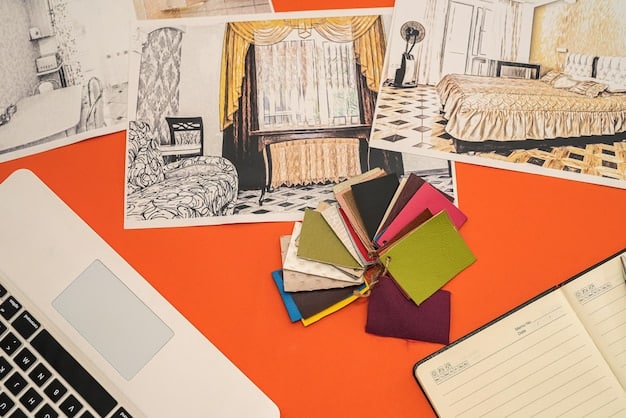
Essential Tools and Techniques for Upcycling
Having the right tools and knowledge of basic sewing techniques is crucial for a successful upcycling project. A sewing machine, fabric scissors, seam ripper, and measuring tape are essential. Additionally, understanding basic alterations like hemming, darting, and adding embellishments will expand your creative possibilities.
Mastering these tools and techniques will empower you to bring your design ideas to life. Here’s a breakdown of what you’ll need:
Must-Have Tools
Gather these essential tools before you begin:
- Sewing Machine: A reliable sewing machine is essential for stitching seams and creating new structures.
- Fabric Scissors: Sharp fabric scissors ensure clean cuts and precise alterations.
- Seam Ripper: This tool is invaluable for removing seams and making adjustments to the original dress.
- Measuring Tape: Accurate measurements are crucial for achieving the desired fit and proportions.
In addition to these basics, consider investing in tools like an iron, pins, and chalk for marking fabric. With the right equipment, you’ll be well-prepared to tackle any upcycling challenge.
Step-by-Step Guide: Transforming Your Dress
Now, let’s dive into the transformation process. Start by carefully inspecting the dress and planning your design. Next, disassemble the dress, cutting away unwanted parts and reshaping the remaining fabric. Finally, reassemble the pieces, adding embellishments and details to bring your runway-inspired vision to life.
This hands-on approach allows you to create a dress that is not only stylish but also uniquely yours. Here’s a detailed guide to help you through each step:
Detailed Steps
Follow these steps to transform your thrift store dress:
- Sketch Your Design: Create a detailed sketch of your envisioned runway-ready outfit, noting specific alterations and additions.
- Disassemble the Dress: Use a seam ripper to carefully take apart the dress, separating the fabric pieces you plan to reuse.
- Cut and Reshape: Cut the fabric pieces according to your design, reshaping them to create new silhouettes and details.
- Sew and Assemble: Use your sewing machine to stitch the pieces together, following your sketch and making adjustments as needed.
Throughout the process, don’t be afraid to experiment and make changes. Upcycling is all about creativity and improvisation, so embrace the unexpected and let your imagination guide you.
Adding the Runway Flair: Embellishments and Details
To truly make your upcycled dress runway-ready, focus on adding unique embellishments and details. Consider incorporating elements like sequins, beads, lace, or even unconventional materials like recycled plastic or metal. These additions can elevate the dress from a simple thrift store find to a high-fashion masterpiece.
The key is to create visual interest and texture, making the dress stand out. Here’s how to achieve that:
Creative Embellishments
Explore these embellishment ideas:
- Sequins and Beads: Adding shimmering sequins or intricate beadwork can instantly elevate the dress’s glamour.
- Lace and Appliqués: Incorporate lace panels or appliqués to add texture and visual interest.
- Recycled Materials: Use unconventional materials like recycled plastic or metal to create unique embellishments that reflect your commitment to sustainability.
Whether you choose subtle accents or bold statement pieces, embellishments are crucial for making your upcycled dress runway-worthy. They add personality and flair, transforming the dress into a true work of art.
| Key Point | Brief Description |
|---|---|
| 👗 Thrift Store Find | Start with a $10 thrift store dress. |
| ✂️ Design & Alter | Sketch, cut, sew, and reshape the dress. |
| ✨ Embellish & Detail | Add sequins, lace, or recycled materials for flair. |
| 💃 Runway Ready | Transform the dress into a high-fashion statement. |
FAQ
▼
Durable and versatile fabrics like cotton, denim, and linen are ideal. These materials can withstand alterations and are easy to work with for various design changes.
▼
Runway shows, fashion blogs, and social media platforms such as Pinterest and Instagram are great sources. Look for current trends and unique design elements.
▼
A sewing machine, fabric scissors, a seam ripper, measuring tape, pins, and an iron are the basics. These tools will help you disassemble, cut, and reshape the fabric effectively.
▼
Use embellishments like sequins, beads, lace, or recycled materials. Experiment with different textures and colors to create a visually interesting and personalized design.
▼
Yes, upcycling is a highly sustainable practice. It reduces textile waste, lowers the demand for new resources, and encourages creative reuse, making it an eco-friendly option.
Conclusion
Embarking on an upcycling challenge transforms a simple $10 thrift store dress into a runway-worthy outfit through creativity, skill, and sustainable practices. By embracing this trend, you not only create a unique fashion piece but also contribute to a more environmentally conscious fashion industry.
